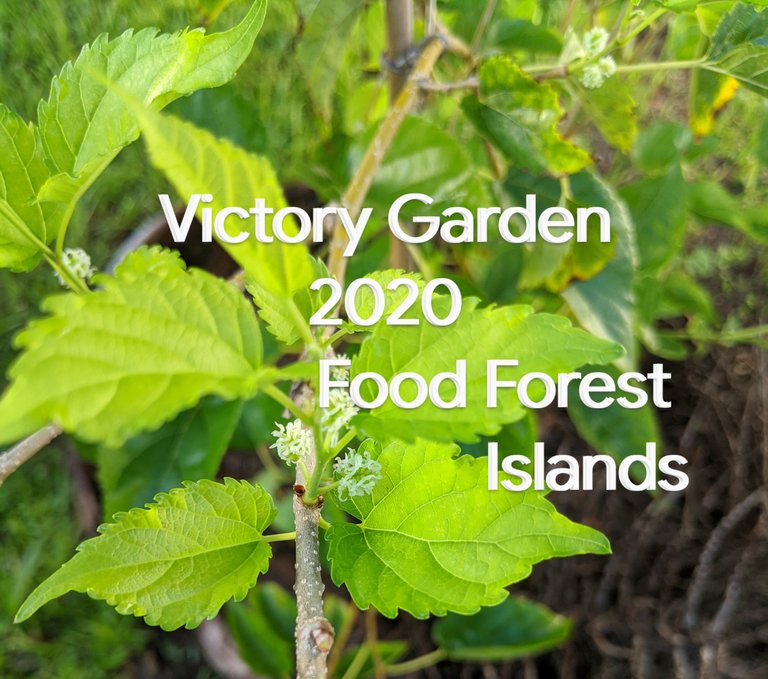
It's autumn in Southwest Florida, so that means a new growing season for all those temperate veggies that can't take our summer heat. Hooray!
Unfortunately, I have neglected my gardening the past few years, and many of my stored seeds are well past their prime. I got two beet sprouts last month and I don't think they made it. Oh, well, I always took a "survival of the fittest" approach to gardening.
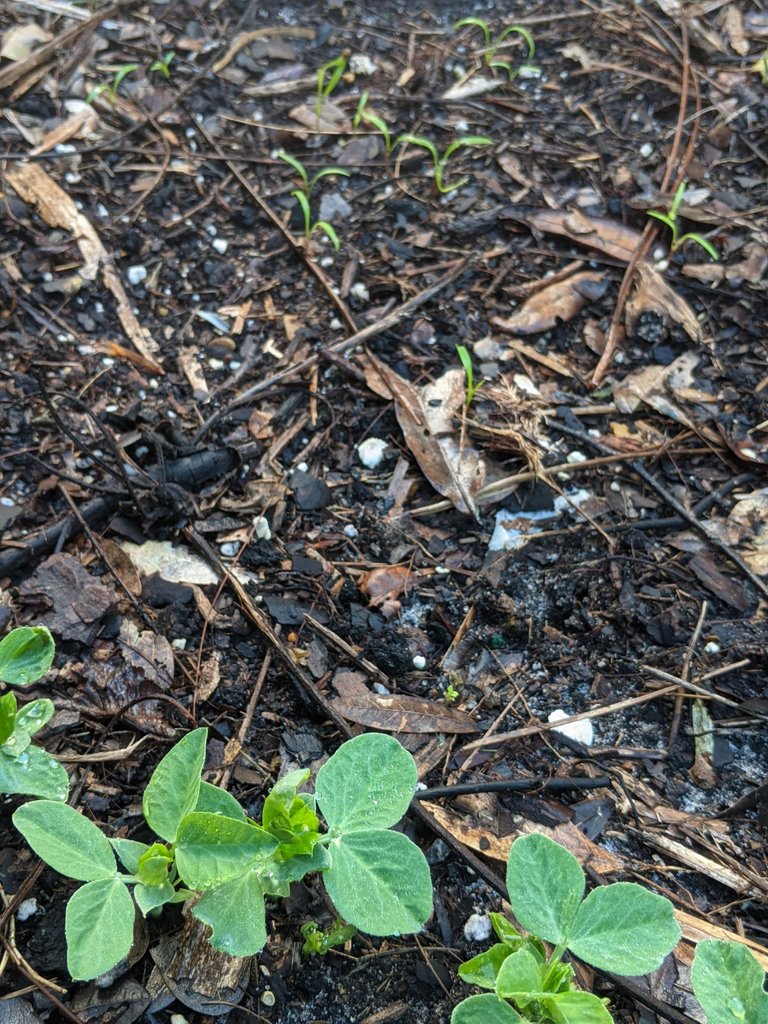
Looks like the carrots and peas are coming up, so while I wait for something more exciting to happen in my food production department we're going to talk about the island method of building productive ecosystems around perennial food producers.
Survival Gardening
My approach to gardening this summer has been largely inspired by my new online mentor, David the Good at The Survival Gardener. Though I had figured out a few things on my own in my last Florida garden, like making use of palm fronds and other leaf litter along with chop and drop biomass plants, I love finding a teacher who actually encourages this behavior, who talks specifically about Florida, and who advocates composting quite literally everything organic!
Your Lawn is a Food Desert
There was a time when I was very anti-lawn. I saw the lawn as all maintenance and no return value. Now that I have a child, I do enjoy having some grass to play around on. However, this points back to the major problem facing modern humans in 2020. Having a comfy place for leisure doesn't feed my family. And it seems that relying on massive industrial systems to provide for my basic needs, in exchange for dollars of dubious value, is not a viable long-term survival plan.
Luckily for all of us, these systems can still provide much of what we need, for now. That buys me time to start building systems around myself.
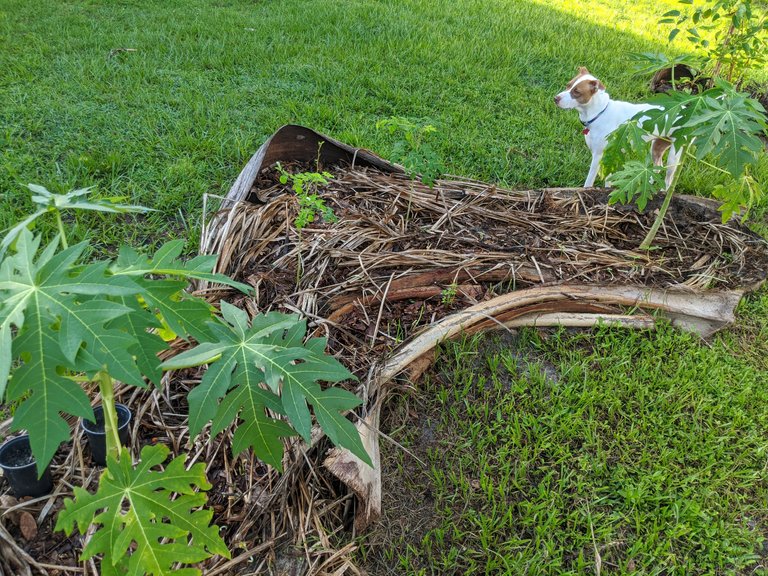
Newly planted island of moringa and papaya, August 2020.
Step 1: Select Anchor Plants
Though step 1 should really be building the soil, I always need plants around which to build my vision. What, in your area, can reliably produce food without a lot of inputs? Think trees, shrubs, perennial vines, root crops, and tenacious greens that can reseed themselves. For me, this list includes:
- banana
- papaya
- mulberry
- moringa
- passionfruit
- cowpeas
- mustard greens
What do you really want to grow? Though I need to help these plants along a little, I really want to grow:
- peaches
- starfruit
- dragonfruit
- blackberries
- blueberries
- olives
This list is influenced by what I think I can grow. Apples would make my list, but they aren't too happy in the subtropic zones.
If you need food now (and don't we all?) David the Good recommends starting with fast-growing calories, including nitrogen fixers to prepare your soil to support more nutrition. That often means root crops. I kind of skipped that step. I have some root crops, but not nearly enough. Same for nitrogen fixers. In a future article, I hope to inform you I've become more responsible and added yams, cassava, and pigeon peas to my mix.
Step 2: Build Islands Around Each Anchor Plant
I focus on trees and perennials early, because they take a while to grow and once you establish them, you aren't going to move them. That means the 8" tall, 1 gallon banana pups I bought need to go in the ground some place where they'll get enough water, sun, and space to grow into 8-10' tall (dwarf) trees. I think about microclimates and seasons, and where each plant might be happy long-term. I didn't get all of it right. Poor Starfruit, I didn't think of how much heat and sunlight radiated off of the white vinyl fence and cinder block walls that surrounded you on three sides. But what really did you in was the damage done to your trunk by a well-meaning lawn care guy with a string trimmer. That was before I built each anchor plant its own island.
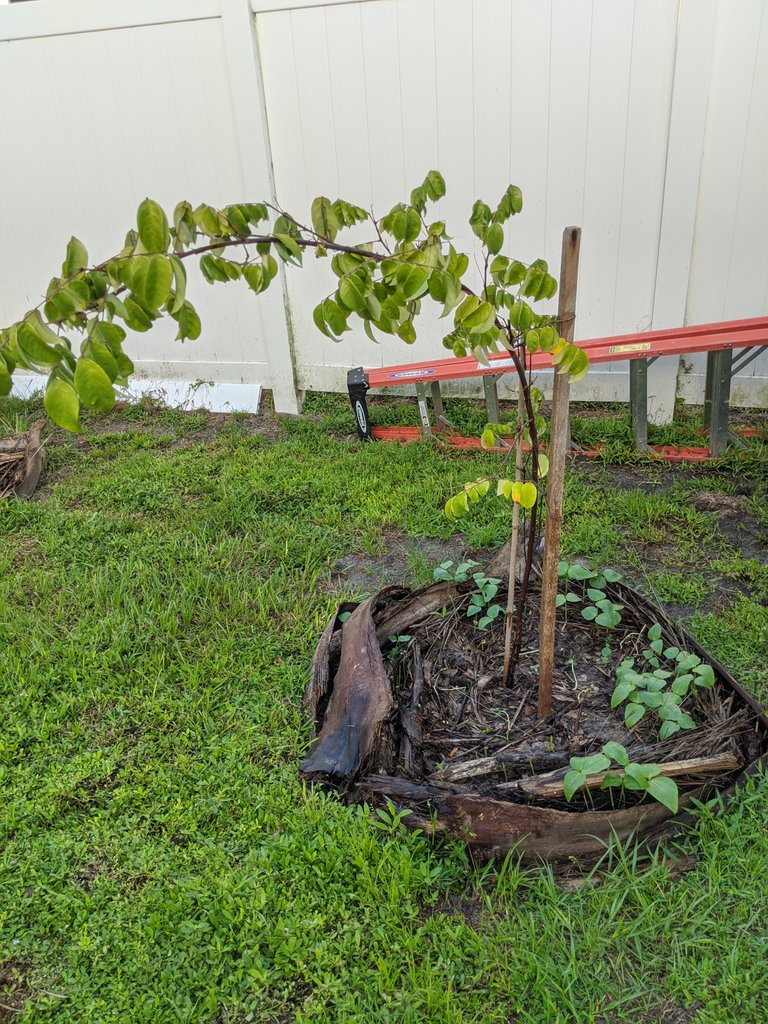
Starfruit in newly constructed island.
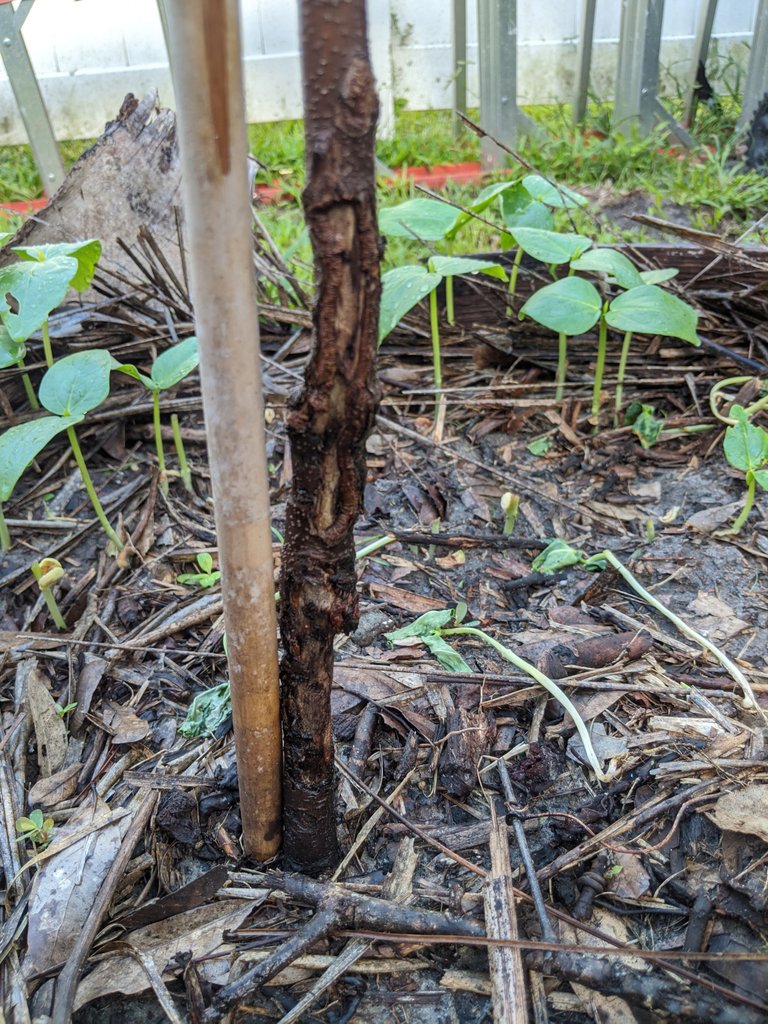
Too little, too late.
The "island" allows your food producers to claim territory from your existing lawn, well before they are strong enough to claim it on their own. It builds the soil with organic matter, and helps to keep the roots of your new plants wet. To build your island, define the borders with some kind of edging material (I do not have money to buy fancy edging, but I do have plenty of fallen palm fronds.) Fill the space with a generous amount of organic material (I gather oak leaves and decomposing palm/palmetto leaves, easily found in my yard and the lot next door.)
Take care to leave a few inches of space around the stalks of your new plants. Wet mulch against the bark is harmful for most species.
Since grass is tenacious here, I like to put down a layer of cardboard wherever I am building an island. Once covered with 3 inches of organic matter, it does a fair job of smothering the grass and it breaks down over 3-6 months. If I'm trying to put plants through, it isn't too hard to break through and push the layer aside, even early in this process.
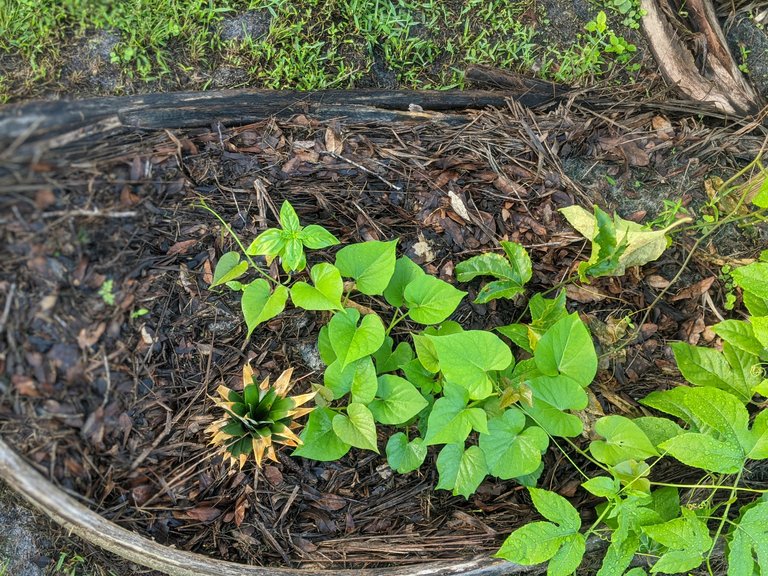
Passionfruit, sweet potato, basil, and a newly planted pineapple top near banana island.
Step 3: Fill Your Islands With Life
There's a problem with piling mulch under a new plant. The mulch will soak in a lot of the water and nutrients that would otherwise go straight into (and through) the soil. While this helps in the long run, your new food forest plants need more support. This is the fun part. On each new island there is room for a gardener to play.
New trees aren't shading the soil beneath them yet. You can help shade the soil by planting greens, vines, legumes, and other plants that will keep the soil cool, channel water and nutrients into the root zone, add their own nutrients to the soil, and feed you at the same time! Since these plants are far less permanent, it's a place to experiment with shorter-lived plants and learn what conditions they like.
For example, I found out that in fall, tomatoes and amaranth do much better in that island that used to contain starfruit, due to the reflected sunlight, than they do in my main garden bed, which is getting more shade this time of year. I learned that the front yard, under the baby olive tree, is apparently a mustard green's FAVORITE spot, though I have no idea why (probably sun vs shade, again.)
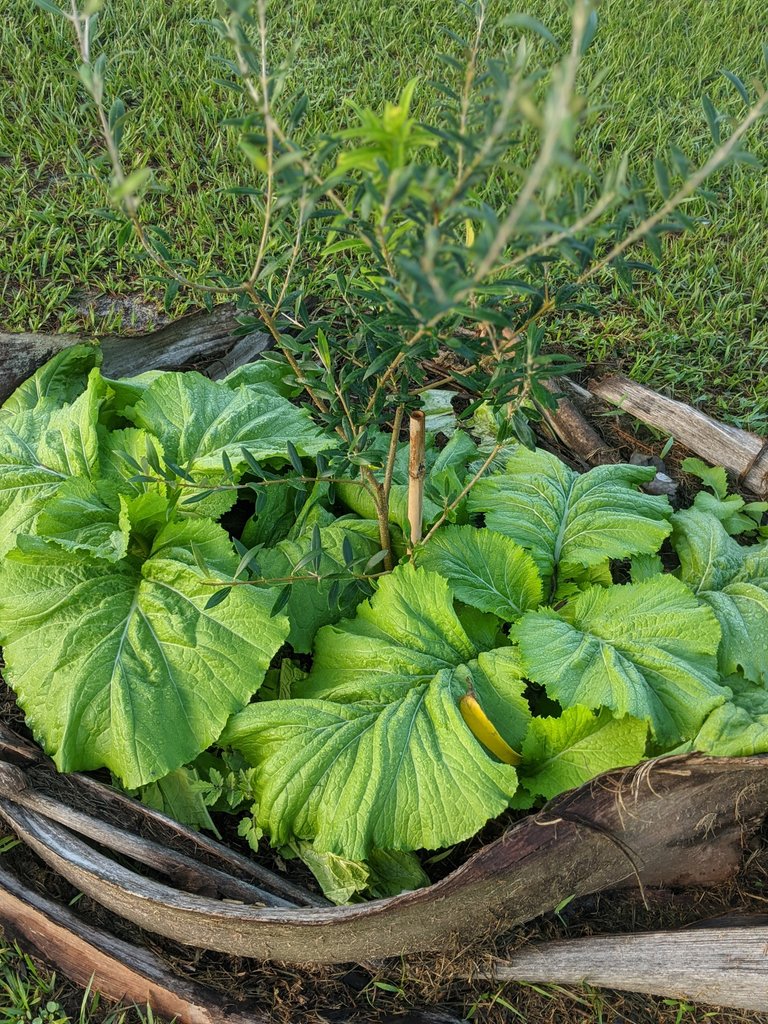
Mustard greens and baby olive tree, October 2020.
Step 4: Harvest, Re-assess, and Keep Planting!
This summer, cowpeas and bananas were a great mix. My bananas are now nearly 5' tall, and the cowpeas have been harvested. The shade there is now so deep, I don't think I could do cowpeas there again, even in Spring. What now? I'm not sure, I'll let you know.
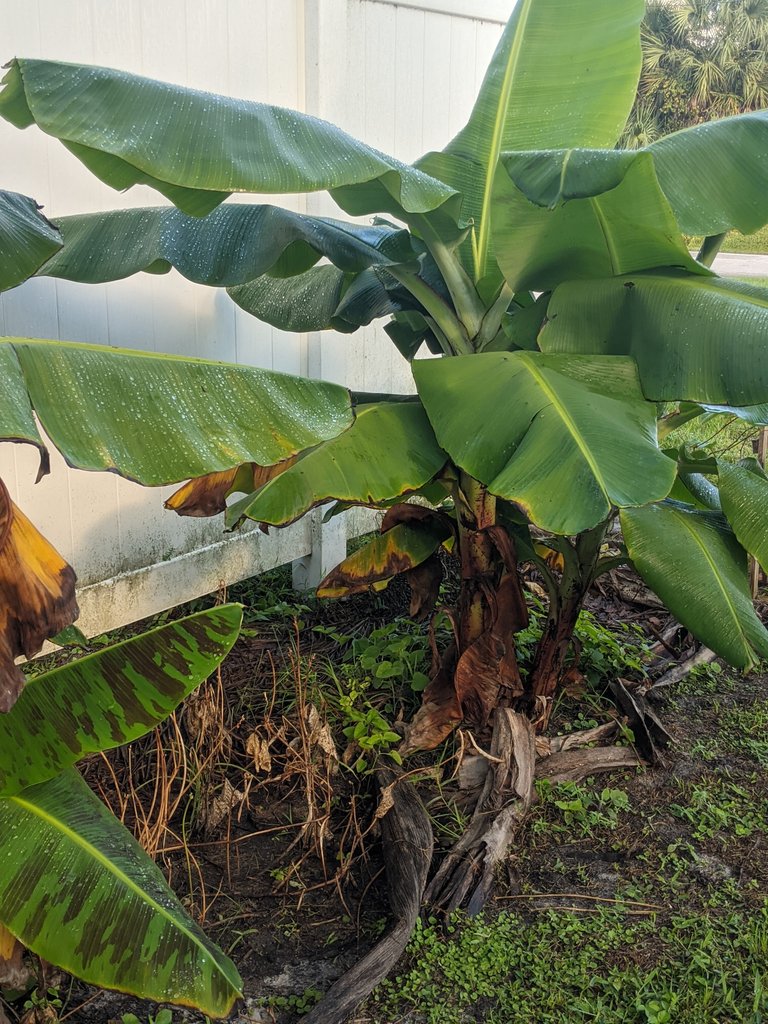
Growing Banana island, October 2020. (No more cowpeas.)
My peach seems to be struggling, though it's also time to go dormant, so it's hard to tell. If the peach doesn't make it I might get a mango instead. I tried pumpkins and cowpeas in that island, and both did poorly. I think the soil there is abysmally poor. Maybe I will dump my entire next batch of compost there. Maybe that's where I ought to put the cassavas and pigeon peas.
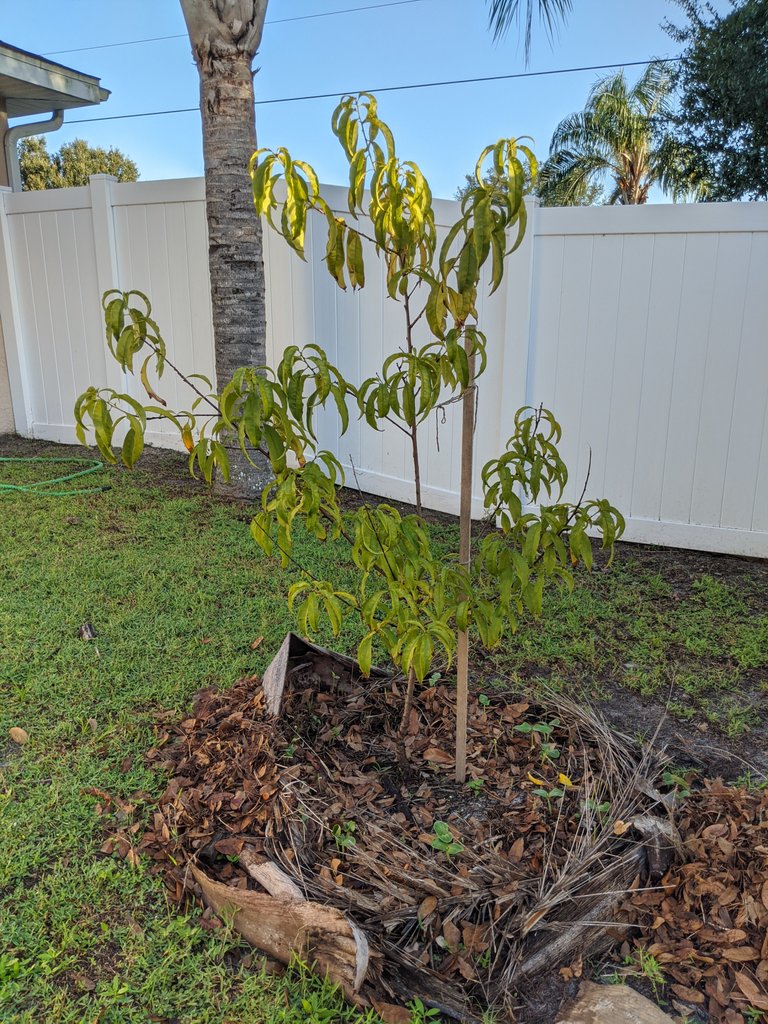
Peach island in August 2020. It looks worse now. 😔
As your islands grow (and they will, even with some setbacks,) they can expand and connect one to another. This weekend I expanded Papaya island to reach the fence. The Moringas there are large enough to cut back, and Papaya island is also home to some okra, red potatoes, basil, amaranth, aloe vera, and milkweed (food for butterflies and pollinators, but not for me.) I planted cowpeas there too, but the gopher tortoises ate them all.
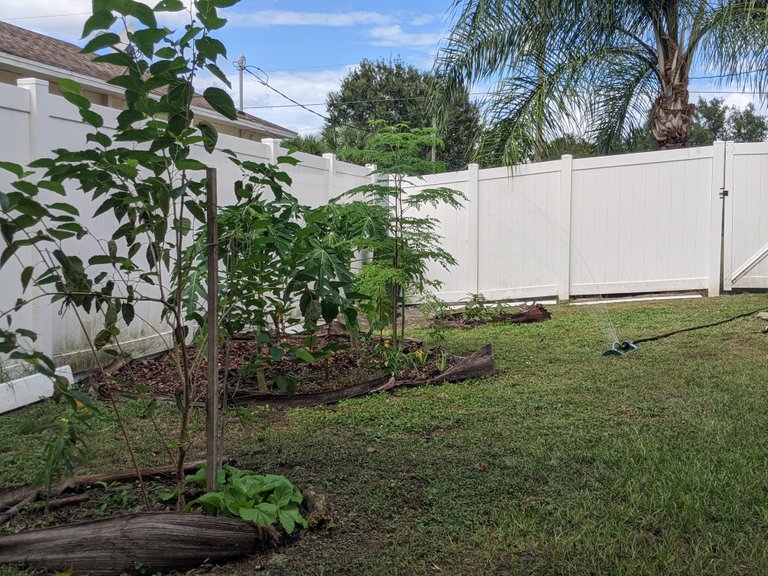
Growing Papaya and Moringa island, with Mulberry island visible in foreground and Amaranth/Tomato (formerly Starfruit) island in the distance.!
Winter in South Florida rarely goes below freezing, so the main challenges are short days and drought. While I build up the soil in my food forest islands, I can grow and harvest greens, daikon radish, and peas. In fact, I need a lot more legumes.
We'll cover chop and drop in a future article. Enjoy fall!
I’ve featured your excellent post in The Lotus Garden newsletter, which will be published tomorrow.
Curated for #naturalmedicine (by @minismallholding) - join our community here.
Did you know it's World Mental Health Month? Or that you can earn a badge from @hivebuzz for posting about #mentalhealthawareness? Read more details here!
The Lotus Garden is a newsletter supporting content relevant to Homesteaders & supported by Natural Medicine. Earn LOTUS & HIVE for your #homesteading content!
About II Discord II Community
I don't live in Florida, but I still enjoy and learn a lot from David The Good. Not only is he knowledgable, but he's also a great entertainer. Have you caught any of his YouTube Live broadcasts? The are great!
I'm kind of jealous of your climate. lol We just planted our first fruit trees earlier this year, but we didn't get to do anything cool like bananas. If our food system ever fully collapses and everything goes local, I think bananas will be the thing I miss the most... besides coffee.
Awesome post! I really enjoyed reading it!!
This climate is definitely something to be reckoned with. There are plenty of temperate things I just can't make work here, so I had better embrace the bananas!
I think it's possible to grow coffee here in the right microclimate, so maybe if the grid goes down we'll find a way to work out some trades.
Occasionally I catch David the Good live, but more often I'm just listening to audio of past streams on Unauthorized tv. He's very entertaining, and I've definitely adopted the "compost everything" approach since finding his streams.
Hi wholeself-in,
Visit curiehive.com or join the Curie Discord community to learn more.
This is really, really useful. Got me thinking how my own is organised and I think I'm kinda on the money for my climate. I say this covered in dirt - and just realised I left a huge seedling tray of cummin in hot sun and I best dash out there and plant them before they die. Bugger. Thanks for sharing - great to see proper permie posts here.
Thank you, I'm glad you enjoyed it!
I do much of my blogging covered in dirt too.
You might enjoy the work of David the Good. It's permaculture (or as he calls it "survival gardening" with a very practical approach, and generally focused on warm climates since he's mainly lived/worked in FL and the tropics.